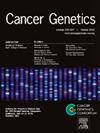揭示口腔鳞状细胞癌的预后生物标志物:一种基于可解释人工智能的方法
IF 2.1
4区 医学
Q4 GENETICS & HEREDITY
引用次数: 0
摘要
口腔癌是世界上最严重的恶性肿瘤之一,也是导致死亡的主要原因。预后差的原因是疾病的局部复发和远处转移。迫切需要确定可能有助于口腔癌预后和治疗的潜在生物标志物。本研究旨在利用可解释人工智能(eXplainable artificial intelligence, XAI)寻找口腔鳞状细胞癌(OSCC)的潜在预后生物标志物。在对来自GSE31056(38例复发和58例非复发OSCC样本/正常口腔组织样本)的微阵列数据进行整理后,将XAI应用于基于二元分类数据集训练的极端梯度增强算法机器学习(ML)模型。在成功地将SHapley Additive explanation值纳入ML模型后,确定了20个与OSCC复发相关的重要基因。关键基因包括FAM49B、TTC39A、IFI16、ANGPTL4、HSPH1、GRIA2、SERF2等,这些基因对细胞生长、细胞侵袭、细胞凋亡、疾病进展、总生存和无病生存起着至关重要的作用。此外,基因网络及其靶向microRNAs (miRNAs)显示,miRNAs hsa-let-7b-5p、hsa-miR-27a-3p和hsa-miR-124-3p与基因的相互作用最高。预测的基因和mirna可能是有价值的预后标志物,并为了解侵袭性OSCC的潜在途径和识别治疗靶点开辟了可能性。本文章由计算机程序翻译,如有差异,请以英文原文为准。
Unraveling prognostic biomarkers in oral squamous cell carcinoma: An approach based on explainable artificial intelligence
Oral cancer is among the top malignancies and the leading cause of death worldwide. Poor outcomes are attributed to local recurrence and distant metastasis of disease. There is an urgent need to identify the potential biomarkers that may help in prognostication and management of oral cancer. This study aimed to find potential prognostic biomarkers for oral squamous cell carcinoma (OSCC) using eXplainable artificial intelligence (XAI). After the curation of microarray data from GSE31056 (38 relapsed and 58 non-relapsed OSCC samples/ normal oral tissue samples), the application of XAI on Extreme Gradient Boosting algorithm machine learning (ML) models trained on binary classification datasets was employed. After successfully incorporating SHapley Additive exPlanations values into the ML models, 20 top significant genes associated with the relapse of OSCC were identified. The key genes included FAM49B, TTC39A, IFI16, ANGPTL4, HSPH1, GRIA2, SERF2 and others which contribute crucially to cell growth, cell invasion, apoptosis, disease progression, overall survival and disease-free survival. Further, a network of genes and their targeting microRNAs (miRNAs) revealed that miRNAs hsa-let-7b-5p, hsa-miR-27a-3p and hsa-miR-124–3p, had the highest interactions with genes. The predicted genes and miRNAs might be worthy prognostic markers and open the possibilities to understand the underlying pathways and recognize therapeutic targets for aggressive OSCC.
求助全文
通过发布文献求助,成功后即可免费获取论文全文。
去求助
来源期刊

Cancer Genetics
ONCOLOGY-GENETICS & HEREDITY
CiteScore
3.20
自引率
5.30%
发文量
167
审稿时长
27 days
期刊介绍:
The aim of Cancer Genetics is to publish high quality scientific papers on the cellular, genetic and molecular aspects of cancer, including cancer predisposition and clinical diagnostic applications. Specific areas of interest include descriptions of new chromosomal, molecular or epigenetic alterations in benign and malignant diseases; novel laboratory approaches for identification and characterization of chromosomal rearrangements or genomic alterations in cancer cells; correlation of genetic changes with pathology and clinical presentation; and the molecular genetics of cancer predisposition. To reach a basic science and clinical multidisciplinary audience, we welcome original full-length articles, reviews, meeting summaries, brief reports, and letters to the editor.
 求助内容:
求助内容: 应助结果提醒方式:
应助结果提醒方式:


